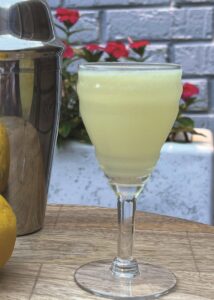In a previous life I went to divinity school. Suffice it to say, at the time it seemed like a good idea.
Perhaps because the school I landed at was Harvard, I found myself among a dwindling number of avowed practicing Christians in the student body. A small but faithful remnant, we observed the rounds of fasts and feasts with as much gusto as we could muster.

In my first year, a group of us Episcopalians and other Anglican types planned to observe the holiest liturgy of the Christian year — the Great Vigil — at a Cambridge monastery we frequented. The vigil would be held in the predawn hours of Easter Sunday, and then we would gather at one classmate’s Porter Square apartment for a potluck brunch. I was charged with bringing something to drink.
I settled on an old-fashioned drink, beloved in New Orleans, the city where I first got to know it, and one that certainly seemed aptly named: the Corpse Reviver.
The cheeky name at first referred to any number of cures to aid recovery after a night on the town. But the cocktail I mixed is the Corpse Reviver No. 2, a version devised by Harry Craddock — the American bartender who went to London during Prohibition. The Savoy Cocktail Book (1930) from his years at the American Bar at the Savoy Hotel is a classic.
Not only was the drink in keeping with the major theme of the day, but we would all be bleary-eyed after rising at 2 a.m. for services. A drink suggesting itself as “hair of the dog” was spot on. As I knew they would, my friends found the Easter morning cocktail both restorative and refreshing, with enough kapow! to get us over our fatigue.
While my career ended up going in a different direction, I learned a lot in divinity school. It was there that I honed my skill at pairing even the most obscure feast with just the right cocktail — a skill that has come in handy more than once in my life.
Corpse Reviver No. 2
Makes one cocktail
This recipe calls for simple syrup, which is just equal parts sugar and water, simmered together to dissolve the sugar, then cooled. Make it with a cup of each and refrigerate what you don’t use. It’s good for mixing into cocktails or lemonade or tea. Cocchi Americano, if you can find it, is an aperitif wine with the bitter edge of quinine that Lillet, which was reformulated in the 1980s, had in Harry Craddock’s day.
1 oz. gin
¾ oz. Lillet Blanc or Cocchi Americano
¾ oz. Cointreau
¾ oz. lemon juice
¼ oz. simple syrup
2 dashes Absinthe or Pastis
A thick lemon twist for garnish
Combine all ingredients in a cocktail shaker over ice and shake well. Strain into a chilled coupe and garnish by twisting the lemon twist over the glass to release its aromatic oil.
